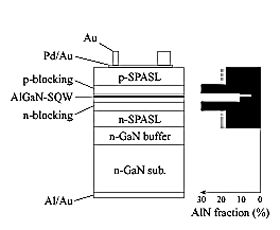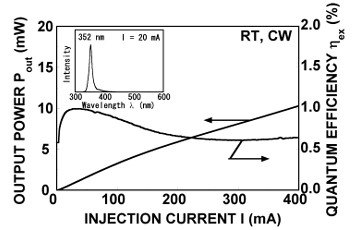Physical Science Research Laboratory
Å@Aluminum gallium nitride (AlGaN) is a wide band-gap semiconductor having optically direct transition. Therefore, it will provide solid-state ultraviolet (UV) light sources in the wavelength range of 200 - 360 nm. Such UV light sources have a wide variety of application fields, including lighting, displays, spectrofluometry, photo-catalytic processes, and high resolution optics.
Å@For efficient light emission or, in other words, radiative recombination, the introduction of quantum well (QW) structure is desirable. We have, so far, clarified that suppressing the internal polarization field in nitride heterostructures can enhance radiative recombination. To improve the performance of UV light emitting diodes (LEDs) consisting of the AlGaN material system, we introduced a short period alloy superlattice (SPASL) for the electrically conductive and optically transparent cladding layers and for high-Al-content current blocking layers to achieve effective current injection [1]. We also introduced high-quality GaN bulk substrate to suppress non-radiative recombinations at crystal defects [2].
Å@The structure of the UV-LED has 2-nm-thick AlGaN single quantum well (SQW)
as an active layer, which suppresses the internal polarization field. This
active layer is sandwiched by n-type and p-type Al0.3Ga0.7N
current blocking layers, and by n-type and p-type SPASL (Al0.16Ga0.84N
/ Al0.2Ga0.8N, 3nm period) cladding
layers (Fig. 1). This device achieved a maximum output power of 10 mW at the
emission wavelength of 352 nm (Fig. 2), which is higher than the previous
record in this UV wavelength range by one order of magnitude. The highest
external quantum efficiency is 1 %, and the estimated internal quantum efficiency
is as high as 80 % [2], which is comparable to that of conventional LEDs in
the visible wavelength range. Further, its emission spectrum is highly monochromatic
without any significant deep level emissions in the visible range.
Å@We have also demonstrated the efficient application of this short wavelength UV-LED to the excitation of fluorescence materials of the three basal colors (red, green, and blue) used in lighting and display devices [3].
[1] T. Nishida et al., Appl. Phys. Lett. 78 (2001) 3927.
[2] T. Nishida et al., Appl. Phys. Lett. 79 (2001) 711.
[3] T. Nishida et al., Phys. Stat Sol. (a) 188 (2001) 113.
 |
 |
||||
|
|